Fiddle leaf figs are a classic houseplant that has been beloved by plant owners for generations. We gardeners absolutely love our plants and want the best to help them grow big and healthy, and fertilizer to no exception to this.
Read on for this ultimate guide where we break down the best fertilizer for your fiddle leaf fig.
Table of Contents
Why is Fertilizer Important?
Fertilizer plays an important role in aiding the development of your fiddle leaf fig – from proper root growth to large leaves to tall heights! When you grow a plant outside in-ground, your plants have the benefit of natural nutrients that is in the earth.
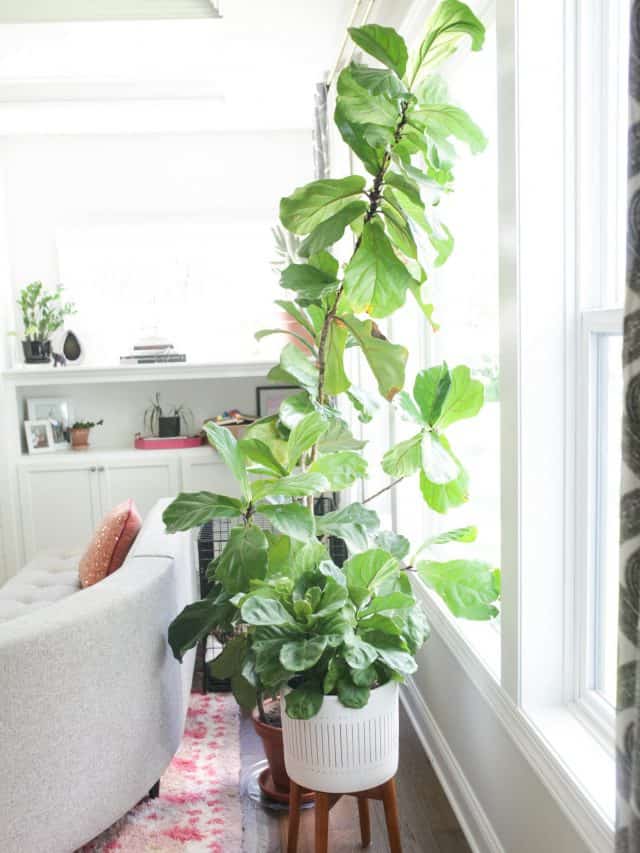
However, houseplants such as the fiddle leaf do not have such benefit. Potted houseplants receive a finite amount of nutrients from their potting soil; eventually the plant will deplete the soil of all essential nutrients.
This is why fertilizer is important when caring for any houseplant, not just the fiddle leaf fig. It reintroduces proper nutrients into the soil to keep your plant nourished throughout its life.
What is the Best NPK Ratio for Fiddle Leaf Figs?
The ideal NPK ratio for your fiddle leaf fig (or ficus lyrata) is a 3-1-2 ratio. In a tight situation, a balanced 1-1-1 ratio is also suitable for the fiddle leaf fig.
3 Different Types of Fertilizer
There are multiple types of fiddle leaf fig tree fertilizer on the market, and each one has a slightly different set of instructions. Fertilizer commonly comes in liquid, granules, and slow release. They all have their own benefits and disadvantages.
Let’s take a look at a few of them:
1. Liquid
Liquid fertilizer is one of the preferred types of fertilizers when it comes to indoor plants. These fertilizers are the easiest to use; they are mixed with water and applied with a watering can. Liquid fertilizer allows you to supply your plant with even coverage, the entirety of the soil will be packed with nutrients.
The only downside to liquid fertilizer is that it must be applied every time, as opposed to slow-release fertilizers. Liquid fertilizer requires you to remember to feed your plant when it is necessary; your fiddle leaf fig will need to be fed monthly during the spring and summer.
Dilute your liquid fertilizer according to the package instructions (keep in mind all brands are different). Pour your fertilizer in a circle around the base of the plant, but take care not to let the fertilizer touch the plant itself; fertilizer is somewhat acidic and touching the branch or foliage can actually cause some damage to the plant. Try and aim the watering can as close to the soil as possible to avoid backsplash.
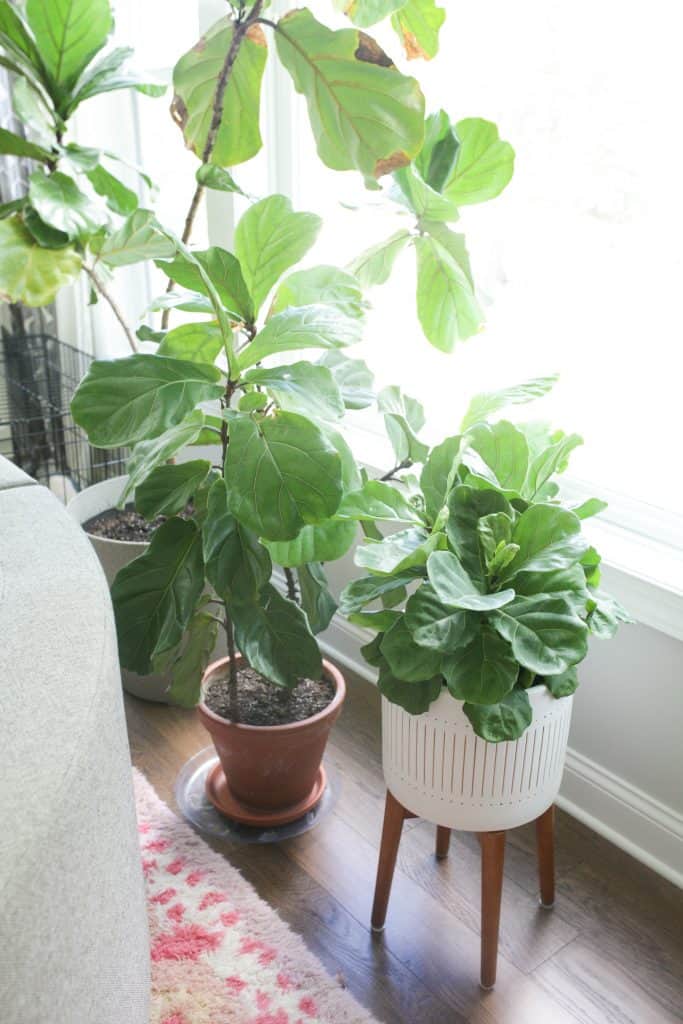
2. Slow Release
Slow release fertilizers are granules that are coated in a time-released shell. Over time, these granules break down and the shells start to dissolve, releasing a slow steady stream of fertilizer into the soil.
These have gained popularity due to their convenience; busy plant owners can apply slow-release fertilizer once during the season and they can be rest assured their plant will be fed. Depending on the type of fertilizer, slow release granules can feed a plant for 4 to 9 months.
However, slow-release fertilizer tends to be costlier than liquid fertilizer. Some plant owners are willing to make the investment because of the convenience of a one-and-done approach to fertilizing.
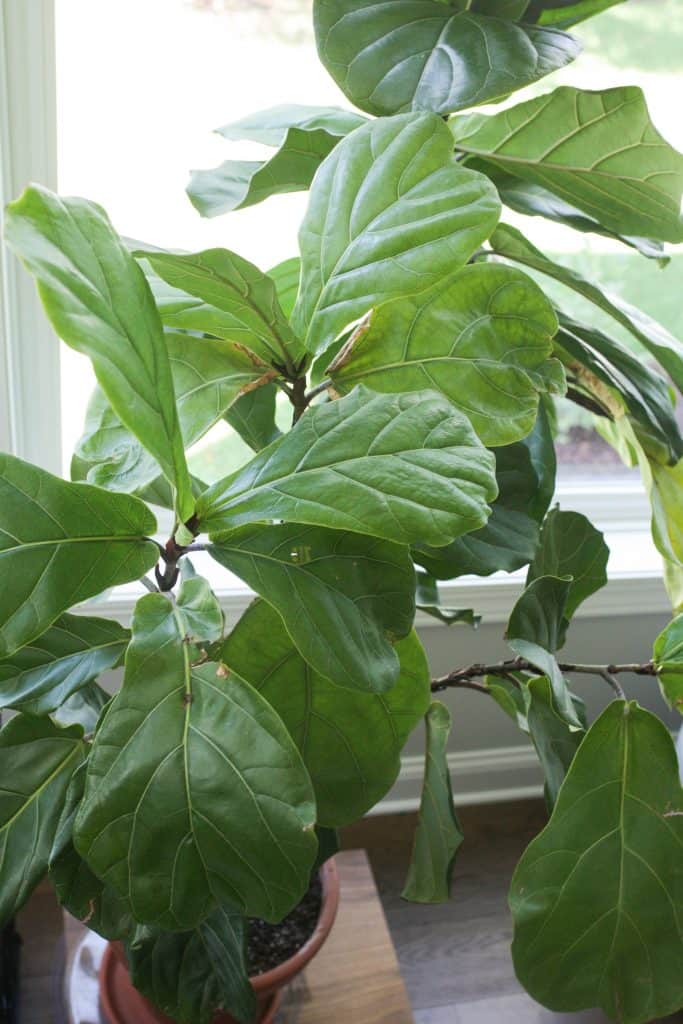
3. Granule
Granule fertilizer is more commonly used for outdoor gardening, though it is possible to use for your indoor fiddle leaf fig. Granular fertilizer is one of the cheaper options for fertilizer, though it can be tricky to use effectively when caring for a fiddle leaf fig.
In order to use this fertilizer, simply mix it into the potting mixture. Granule fertilizer releases all of its nutrients at once, which makes regulating the amount of fertilizer very difficult to do. This fertilizer type is not recommended and should be a last-resort.
When to Use Fertilizer on Fiddle Leaf Figs
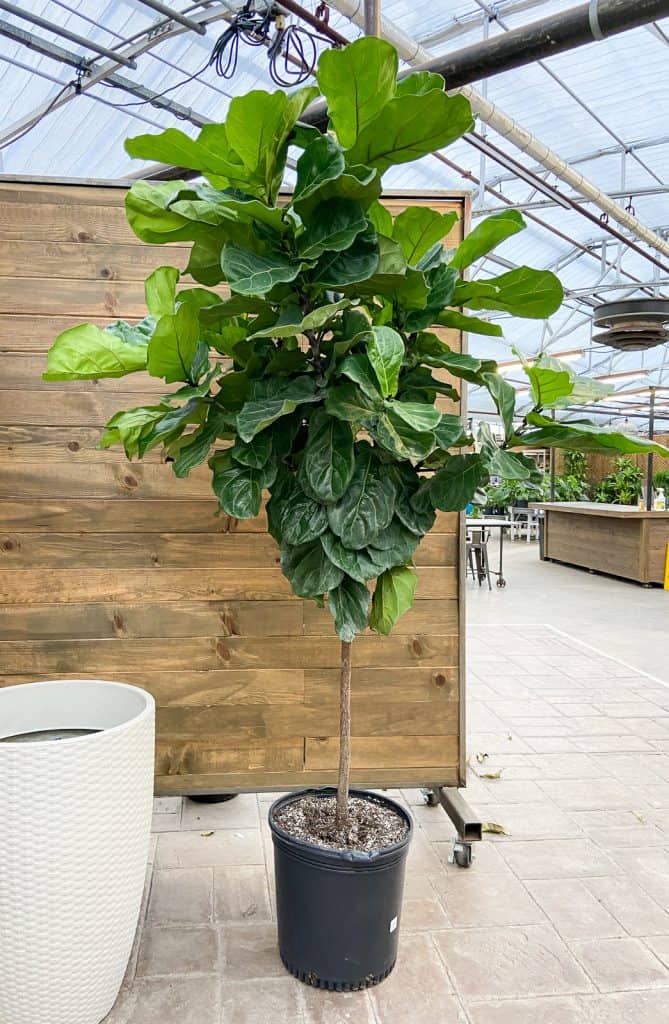
The best time to fertilize your plant is during its most active growing period, the spring and summer. During this time, your fiddle leaf is at its peak growth and requires a steady stream of nutrients to keep it fed during the season. We recommend feeding your plant once per month if you are using liquid fertilizer for your plant.
During the fall and winter months, your fiddle leaf will become dormant and its growth will slow down significantly. Cease all fertilization during this time as your plant has no use for it. If you continue to fertilize your plant, this can cause severe side-effects and be greatly counterproductive. The unused fertilizer can cause the soil to acidify to dangerous levels, causing the plants roots to burn.
3 of the Best Fiddle Leaf Fig Fertilizer
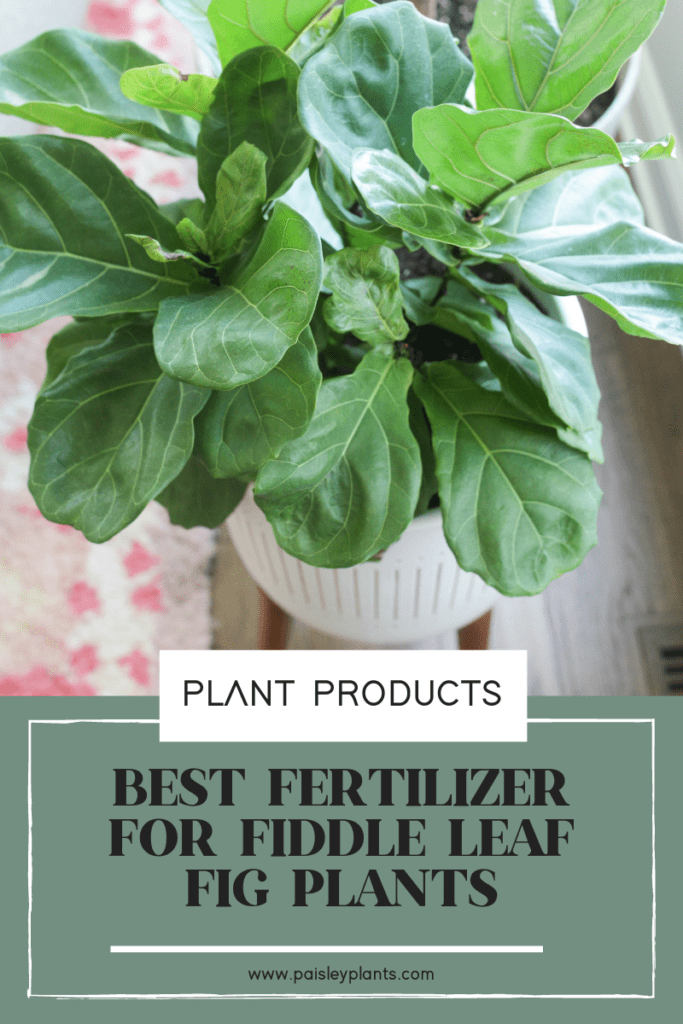
This post includes affiliate links.
1: Fiddle Leaf Fig Plant Resource’s Fiddle Leaf Fig Tree Food
- ARE YOU STARVING YOUR FIDDLE LEAF FIG? Fiddle leaf fig plants require precise nutrients to thrive, promoting their growth, vitality, and robust root systems. Our exclusive Fiddle Leaf Fig Plant Food offers a tailored plant food solution, ensuring optimal nourishment for your beloved plant. Say goodbye to alternatives and provide your fiddle leaf fig with the care it truly deserves.
- THE PERFECT SOLUTION TO PROMOTE VIBRANT AND STUNNING GROWTH: Our original Fiddle Leaf Fig Plant Food is specially formulated to nourish your beloved plant with care and attention. Unlike other plant foods, it contains absolutely no urea that could potentially not good for your cherished green companion. This plant food is designed to be seamlessly integrated into your plant care routine, ensuring a gentle approach to promoting vibrant and stunning growth throughout the entire year.
- INCLUDES FREE FIDDLE LEAF FIG CARE WEBINAR AND E-BOOK: Enhance your purchase with a complimentary Fiddle Leaf Fig Care Webinar and E-Book, which will equip you with the knowledge to cultivate the ideal fiddle leaf fig in your home and address any issues you might encounter.
- CERTIFIED AND TESTED IN INDEPENDENT LAB FOR SAFETY: Don’t fall for imitations; our product is proudly certified, ensuring the utmost safety for your precious plants. Crafted with care in the USA by a woman-owned small business, our plant food nourishes your plants.
- EFFORTLESSLY FEED YOUR PLANTS WITH NO HASSLE OR SPILLS! Simply mix 1 teaspoon of our Plant Food with 2 cups of water, and you’re ready to nourish your beloved plants. Our Fiddle Leaf Fig Plant Food is designed to be gentle and safe for your plants, making it suitable for every watering session. Plus, each 8 oz bottle provides enough plant food to last anywhere from 6 months to a year, depending on the size of your plant.
Why We Love It:
This organic, non-toxic plant food is made specifically for the health of a fiddle leaf fig by a small business that is dedicated to growing amazing fiddle leaf figs. It boasts a 3-1-2 NPK ratio which is the recommended ratio for a healthy fiddle leaf.
One bottle of this fiddle leaf fig plant food can last for one or two growing seasons, depending on the size of your plant.
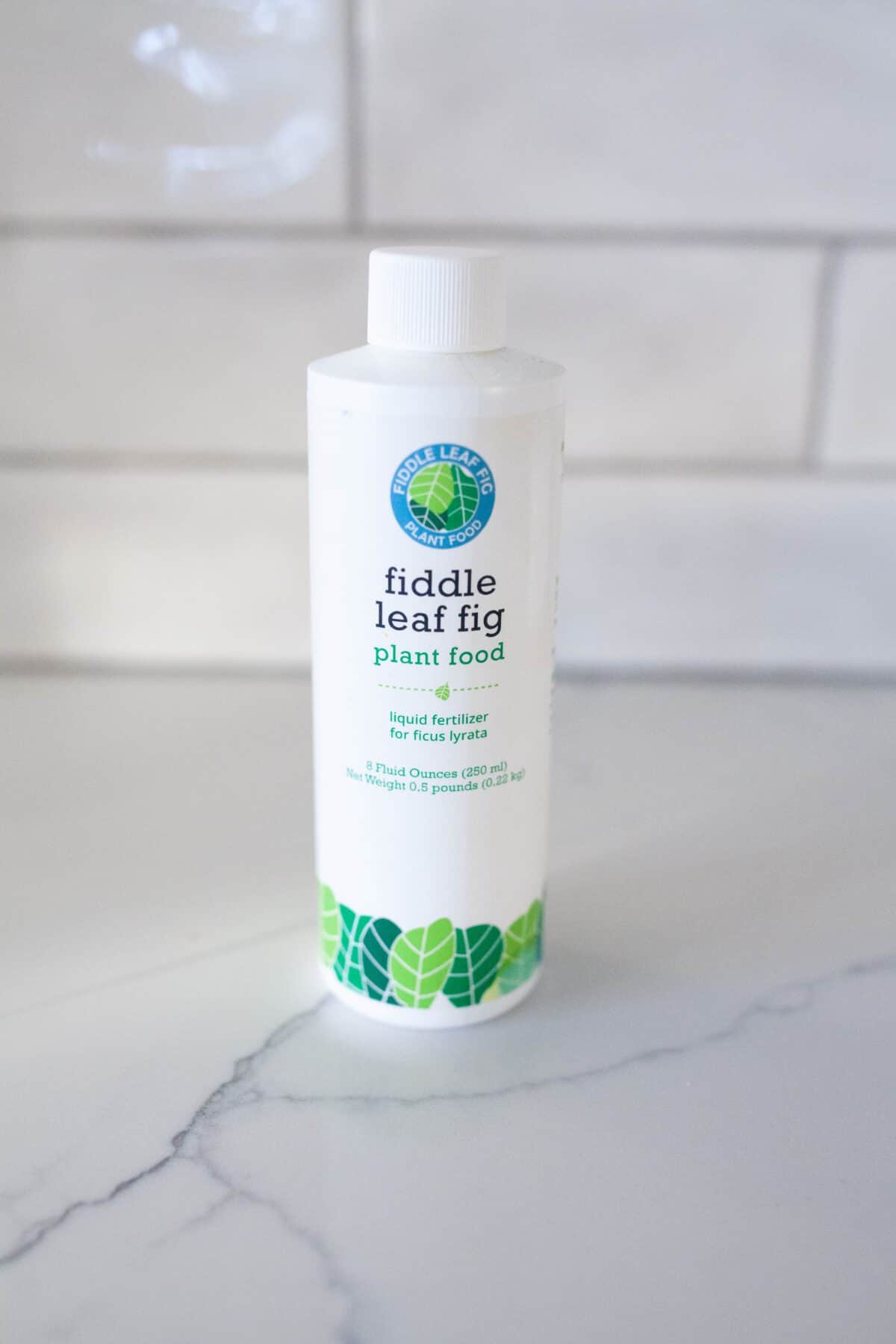
Using this product is easy; simply mix 1 teaspoon of plant food with two cups of water. It also includes a free e-book and care guide to owning a fiddle leaf fig.
I started using this liquid plant food a few years into owning my fiddle leaf and the amount of new growth and new leaves was amazing! I highly recommend this fertilizer for your plant.
2: The Grow Co Fiddle Leaf Fig Tree Plant Food
- ESSENTIAL NUTRIENTS – A balanced mix to feed your ficus that promotes strong root structure, growth and overall better health. Provides the proper nutrients to grow your small fiddleleaf or audrey ficus into a giant!
- FOR VIBRANT GLOSSY LEAVES – Effective for all ficus varieties, indoors and outdoors, this easy to use formula promotes leaves that gloss and shine. Delivers the essential nutrients your plants crave that’s lacking from standard organic soil mixes in pots and planters.
- GENTLE, STEADY FEEDING – A great alternative to liquid fertilizers that can cause overwatering, our fertilizer pellets added to your plant pot gradually feed with every watering, protecting your delicate houseplant from fertilizer burns and too much water.
- LONG LASTING FOR REAL RESULTS – One application added to your planter feeds your ficus trees for up to 6 months! Care for your live houseplants is simple and easy, with no spray or liquid feedings to accidentally forget.
- NATURAL BEAUTY – A live plant is always a great addition to the decor in your house, bringing you cleaner air and a natural vibe. This fertilizer works well for all types of ficus trees in various potting soils: Ficus Lyrata (Fiddle Leaf), Ficus Audrey, Ficus Religiosa (Sacred Fig), Ficus Elastica, (Rubber Tree or Rubber Plant) Ficus Benjamina (Weeping Fig), Alli (Narrow Leaf) and more!
Why We Love It:
This slow-release fertilizer is cost-effective, but it doesn’t skip out on quality. The slow-release granules are easy to measure and apply to your plant. The formula is gentle and safe to use on your fiddle leaf fig’s sensitive root system.
One dosage will last 6 months, enough time to last through the whole spring and summer.
3: Fiddle Leaf Fig Tree Plant Food 6-2-4
- Every requirement of fiddle leaf fig plants were taken into consideration during the forumlation of this fertilizer, which will enhance the healthy growth of your plant
- Provides all the nitrogen, phosphate, potassium, and micronutrients your fiddle leaf plant plants need to maintain healthy deep green leaves
- Simply dilute the high concentrate plant fertilizer into a water solution. This 8oz bottle makes 12 gallons of watering solution
- Includes the highest quality ingredients from our 5th generation family farm ensures the absolute highest quality fiddle leaf plant food for your beloved indoor potted plants
- SPECIALLY FORMULATED FOR FICUS: Can be used to feed: Ficus Lyrata, Ficus Audrey, Ficus Religiosa, Ficus Elastica, Ficus Benjamina (Weeping Fig), Alli, Olympian or Kadota Fig Tree, and Benghalensis
Why We Love It:
This liquid plant fertilizer is a high quality, organic product that is perfect for your fiddle leaf fig trees. This fertilizer has an NPK ratio of 6-2-4, which they say will allow one bottle to last twice as long as other fertilizers
This fertilizer comes in an 8 oz bottle, which is enough to feed a small fiddle leaf for two growing seasons, or enough to feed a large fiddle leaf fig for one growing season.
This fertilizer is specially formulated for ficus and can be used on a variety of plants like Ficus Lyrata, Ficus Audrey, Ficus Religiosa, Ficus Elastica, Ficus Benjamina (Weeping Fig), Alli, Olympian or Kadota Fig Tree, and Benghalensis.
General Fiddle Leaf Fig Care
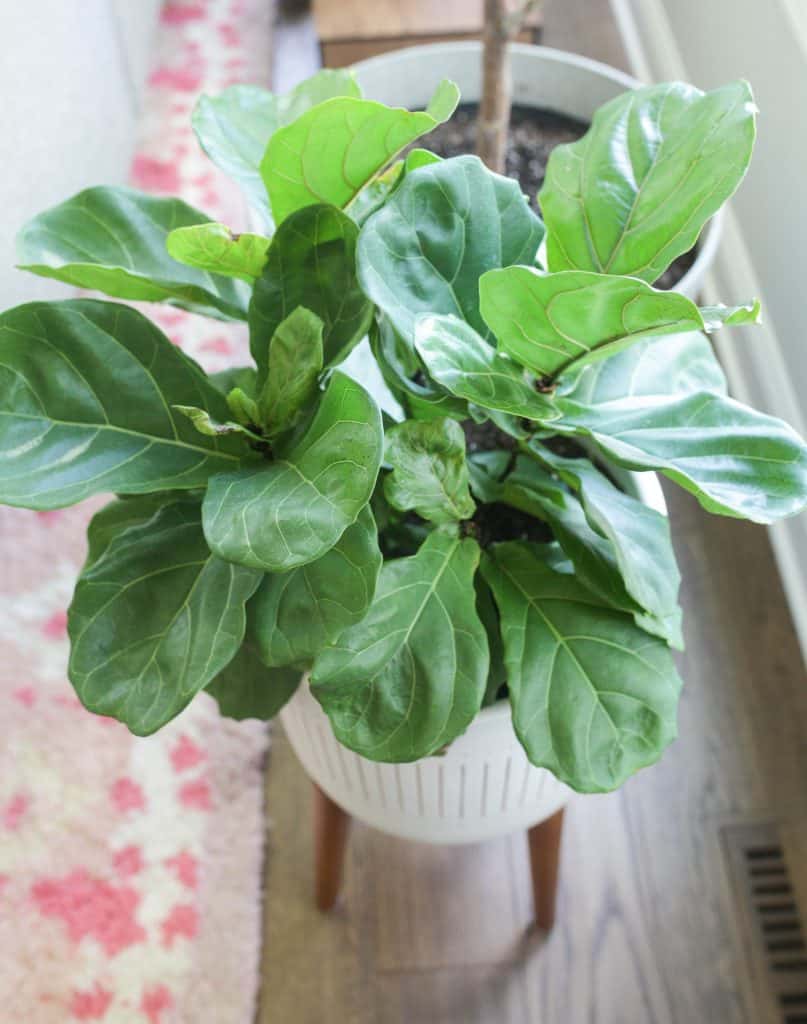
In general, fiddle-leaf fig plants love to have a good amount of indirect sunlight each day. Many experts say that too much direct sunlight can damage your plants leaves or just harm your plant in general. It’s a good idea to keep your plant just just out of reach of the sun so it stays healthy.
I will say, I have 2 of my biggest fiddle leaf fig plants right in front of a large west facing window and it does really well! Keep in mind that your plant has a mind of it’s own and may love a lot of sun (or may need to stay out of the direct rays).
These plants love consistent watering about once a week. These plants can grow to massive heights and live in large pots so they need enough water to saturate their root ball but not too much to cause root rot. Stick your finger into a few inches of soil to see if it’s dry or wet. If it’s wet don’t water it, if it’s dry go ahead! One of the best ways to know if needs water is when the leaves get droopy.
Keep your plant away from drafty areas like air conditioning vents or doors during the winter months.
If you want to know all the best care tips to have perfect plants (or at least mostly happy ones), head to this fiddle leaf fig tree care post! You’ll learn about the best soil and so much more.
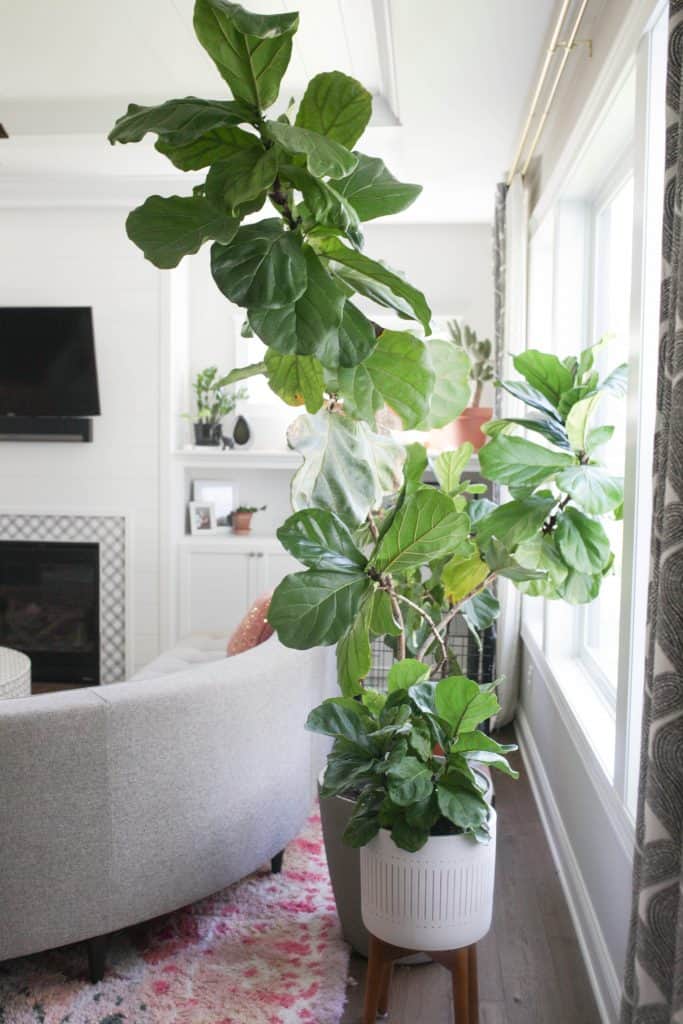
Frequently Asked Questions:
Miracle-Gro is by far one of the most popular fertilizer brands out there; even people who don’t own plants will recognize Miracle-Gro. Miracle-Gro can be a mixed bag of results, some plant owners will criticize it while others prefer it.
Miracle-Gro can definitely work with a fiddle leaf fig. The company manufactures many different types of fertilizers, so be sure to select the right one. We recommend a liquid fertilizer with a 3-1-2 NPK ratio.
If you are on the fence about using Miracle-Gro, we suggest starting with a smaller dosage in order to test how your plant reacts to a new brand.
This is a common symptom of over-fertilization. Too much fertilizer can actually be very counter productive to the development of your plant. Always make sure to read through the directions on the fertilizer that you use. In addition, avoid splashing the foliage with fertilizer as this can outright burn the plant.
Want to know other reasons why your fiddle leaf may have brown spots? Head to this post!
Conclusion
Fiddle leaf figs are a beautiful houseplant that goes perfect in everyone’s home. Houseplants are living creatures so its only natural us owners want the best for their plant. In order to maintain a healthy fortified fiddle leaf, fertilizer is an absolute necessity.
Here’s all the fiddle leaf fun on the blog!




